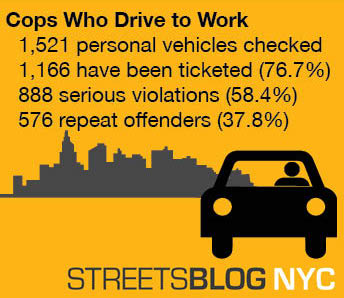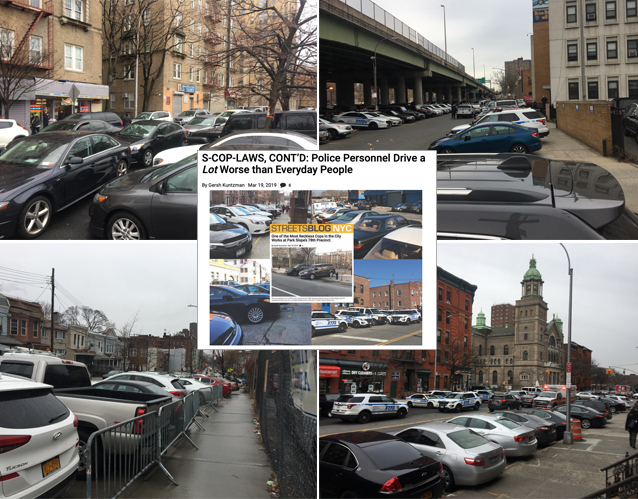We told them so.

Mayor de Blasio and NYPD Commissioner O'Neill were repeatedly warned about recklessly driving officers on the force, but have done nothing to discipline or otherwise rein in the scofflaw cops — moves that might have saved the life of Officer Garman Chen, a speed demon with a long list of moving violations who was nonetheless still behind the wheel when he killed himself in a drag race on the FDR Drive early Saturday.
Chen, who worked out of the 76th Precinct in Carroll Gardens, had 21 violations for speeding or for running a red light since July, 2017 — a record so bad that if a pending Council bill had already been passed and signed into law, his ability to drive would have been removed and he might still be alive.
The car had 14 school zone speeding tickets and 7 tickets for running red lights. https://t.co/aXfMdv8IeO
— Liam Quigley (@_elkue) November 16, 2019
But Chen is just one of thousands of officers who repeatedly drive recklessly. Earlier this year, Streetsblog conducted a months-long series that found that more than 58 percent of police officers who had parked their personal vehicles in NYPD-only spaces near 33 stationhouses in all five boroughs had at least one moving violation — and 38 percent had repeated moving violations.
Those violation percentages, available to the public at howsmydrivingny.nyc, are roughly twice those found on a typical residential street in New York City (reminder: 51 percent of cops live in the suburbs).
On multiple occasions, Streetsblog has asked the NYPD and the Mayor's Office what it intends to do about recidivist officers in their midst, but gotten no response.
Just silence.
(Well, not complete silence, perhaps. The mayor's spokesman Will Baskin-Gerwitz sent over this statement, which included no specifics: "The mayor knows keeping reckless drivers off the streets are crucial to keeping New Yorkers safe, which is why we're working with the Council to reinforce the importance of safe driving and hold all dangerous drivers accountable.")
The silence or platitudes are particularly unnerving, given that in April, when our investigation had been going on for about a month, Mayor de Blasio said he was "concerned" about our findings, adding, "We are going to follow up on that."
At the time, the mayor did not say what action he would take, such as docking vacation pay or issuing suspensions for the worst offenders. Over the next several months, Streetsblog repeatedly asked for an update on whether the mayor had indeed followed up on our findings. Neither the NYPD nor the mayor's office has commented. We have asked roughly once a month since April, we asked again last week and, after Chen's crash, asked again on Sunday.
Again, silence.
On Sunday, Council Member Brad Lander reiterated that his bill — the Reckless Driver Accountability Act — could provide safety even without mayoral initiative. The bill, which is already backed by a majority of Council members, but does not yet have mayoral support, would allow for drivers to lose their cars if they rack up five or more moving violations in any 12-month period — as Officer Chan and countless others have.
"So many lives are lost senselessly to reckless driving, the lives of pedestrians, cyclists, passengers, and drivers themselves," Lander told Streetsblog on Sunday. "The Reckless Driver Accountability Act is designed to save some of them. We'll never know whether Officer Chen's life might have been saved, because we did not have it in place in time. Let's not take any longer to lose more lives we might have saved."
A spokesman for Council Speaker Corey Johnson called the bill “a top priority," and added that the speaker is "working diligently with Council Member Lander and with the administration on this critical issue.” In September, though, the mayor suggested that the bill was not an "urgent" priority.
It is unclear why the NYPD appears to be so unresponsive to the street safety issue right in their midsts. After a wave of police suicides earlier this year, Commissioner O'Neill personally spoke about needing to take action to break the stigma that prevents many cops from seeking mental health services. And the city eventually offered free therapy for officers.
But no such effort has been made to improve officers' physical safety when they are behind the wheel. And there are many bad apples in that particular bunch. Streetsblog's investigation revealed:
- A cop in Downtown Brooklyn's Transit Bureau 30 whose car had been nabbed for 28 moving violations (* and would have been subject to being impounded if Lander's bill was already law).
- A cop in Park Slope with 53 moving violations*.
- A cop on the Upper East Side with 41*.
- A precinct in Canarsie with 53.5 percent of the officers' cars had repeat multiple moving violations. One cop had 14 serious moving violations and another had nine — both of whose cars would have been impounded if Lander's bill was in effect.
- One in Brooklyn where 56 percent of the officers had repeat moving violations and one in Staten Island where 74 percent of the officers had repeat moving violations.
The Streetsblog investigation began in March after de Blasio announced at a press conference about placard abuse that he intended to build more parking for police officers to facilitate their commuting by car.
“We will purchase parking lots, we will lease parking lots, parking garages — whatever it takes … so that our firefighters, our police officers, our EMTs actually have a place that they know they can park,” the mayor said. “Many officers feel they have no choice [but to drive to work].”
But driving to work has led to unsafe conditions for residents of New York, thanks to the high percentage of cops — more than half of whom live in the suburbs — who have multiple moving violations on their record.






